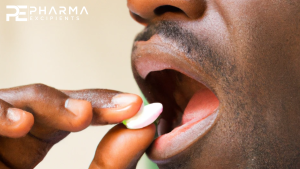An overview of the methods used to increase the dissolution rate of meloxicam for oral administration

Abstract
Oral administration of a drug substance has become one of the most important drug delivery routes. In chronic diseases such as rheumatoid arthritis or osteoarthritis, oral forms of drugs are preferred, not only by patients but also by doctors. Meloxicam (MLX) is pharmacologically classified as a nonsteroidal anti-inflammatory drug (NSAID) and is very common in use. However, taking into the count the physiochemical properties it is hardly soluble in water. Poor solubility causes technological problems in the design of oral dosage forms. Many methods have been developed to modify the drug substance in order to change its physicochemical parameters and improve the rate of dissolution. There can be found publications that describe different methods like: particle size reduction, co-crystalization, anti-solvent precipitation, solid-solid or liquid-solid dispersions, microparticle preparation, complex or salt formation, lipophilic particles, as well as the use of surfactant or co-solvent systems. All of them can be classified as physical or chemical methods. In the publication summary as well as classification of methods used to influence the dissolution of poorly soluble substances was presented.
Introduction
The development of active pharmaceutical ingredients (APIs) with high therapeutic potential is the driving force behind the market introduction of all new drugs. Their poor solubility is the main difficulty in creating their oral dosage forms. As many as 70% of new drug candidates were considered insoluble or poorly water-soluble [1] and they are classified for II or IV BCS Class (Biopharmaceutical Classification System), while only 8% have both high solubility and permeability and can be classified into I group of BCS [2]. In order to achieve therapeutic concentration, sparingly soluble substances usually require high doses [3]. This can lead to gastrointestinal toxicity as well as insufficient and variable bioavailability. Also, for Non-Steroidal Anti-Inflammatory Drugs (NSAIDs) the most common and usually the most serious toxic effects are damage to the gastrointestinal tract (GI), it is also dose related and increased with the age of patient. This group of drug can induce peptic ulcers, petechiae, blood and protein loss into the GI lumen, localized strictures, and bowel wall perforation [4].
In the case of drugs belonging to Class II and IV of BCS poor solubility also determines delayed absorption. Solubility is the most important parameter limiting the speed of achieving the intended therapeutic effect [2]. Factors affecting the dissolution rate include chemical nature, particle size, and the form in which API is present. Solid materials appear in crystalline, amorphous or a combination of this both forms, also they can be found as the solvates or hydrates. The occurrence of one substance in different crystallographic forms is referred to as polymorphism [5].
The aim of the work was to present and summarize methods used to increase the speed of dissolution and the release rate of sparingly soluble substances on the example of meloxicam (MLX). The low solubility can complicate the formulation process and may cause differences in the oral bioavailability. MLX was chosen as the model substance because of its frequent therapeutically usage. MLX due to its analgesic, anti-inflammatory, and antipyretic effects is usually used for the treatment of different chronic inflammatory disorders such as rheumatoid arthritis, osteoarthritis and for the treatment of the pain after operations [6], [7], [8], [9], [10]. The main mechanism of its anti-inflammatory effect is the inhibition of cyclooxygenase-2 (COX-2). It belong to NSAIDs with the lower risk of gastrointestinal adverse effects.
A lot of methods are under the research. All of them prove, that the problem of the bioavailability of poorly soluble substance can be changed or sometimes even solved. This publication was prepared to show that for the same substance many methods can be successfully used. Hopefully, such an image will allow readers to consider the fact, that the choice of method to achieve the effect of increasing the dissolution rate may depend on what the author wants to prepare next, i.e. what final form of the drug will be prepared.
Read more here
Excipients mentioned in the study beside others: Capryol, Miglyol, Labrafil, Labrasol, Eudragit
Barbara Jadach, Anna Froelich, Adam Tatarek, Tomasz Osmałek, An overview of the methods used to increase the dissolution rate of meloxicam for oral administration, Journal of Drug Delivery Science and Technology, 2024, 105836, ISSN 1773-2247, https://doi.org/10.1016/j.jddst.2024.105836.
Read also our introduction article on Orally Disintegrating Tablets (ODTs) here:


